Dental CT
About Our CT System
Enabling Precise Diagnoses
A dental CT (Computed Tomography) scanner is specifically designed for dental care. It provides detailed, three-dimensional images, allowing for accurate diagnoses of bone conditions necessary for implant treatment, the position of wisdom teeth, periapical infections, orthodontic planning, tumors, and other conditions within the oral cavity.
Our digital dental CT scanners emit low levels of radiation, making them safer and more patient-friendly. We have two dental CT units installed in our clinic.
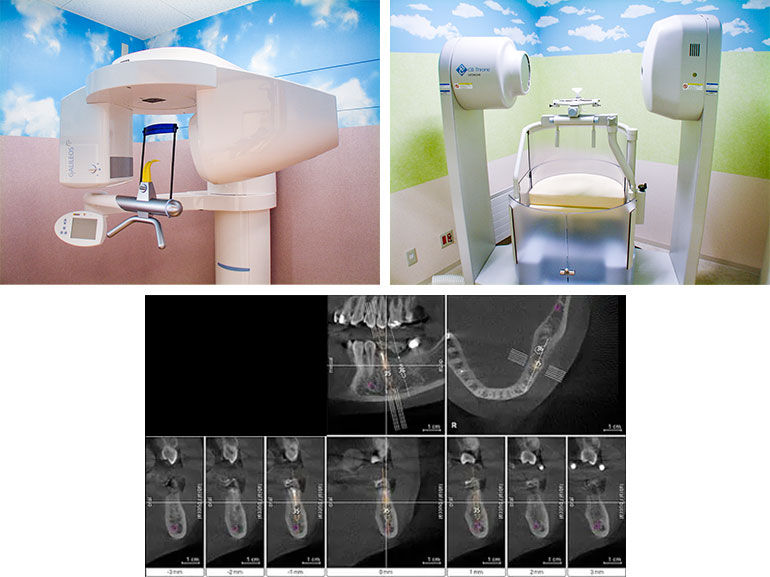
Accurate Imaging for Surgical Procedures
Enabling More Detailed and Efficient Treatments
CT imaging allows us to obtain precise data on the condition of teeth and jawbones, which is difficult to achieve with conventional X-rays. For example, the exact position of impacted wisdom teeth can be clearly identified, allowing for safer and more accurate extractions. In implant treatment, detailed bone structure information enables us to provide higher-quality care.
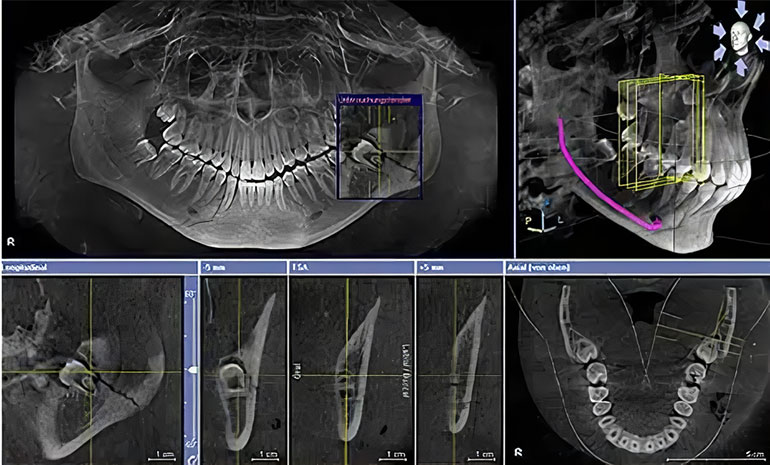
SICAT (Implant Guide System)
We use the SICAT implant guide system to create surgical guides for highly accurate implant placement.
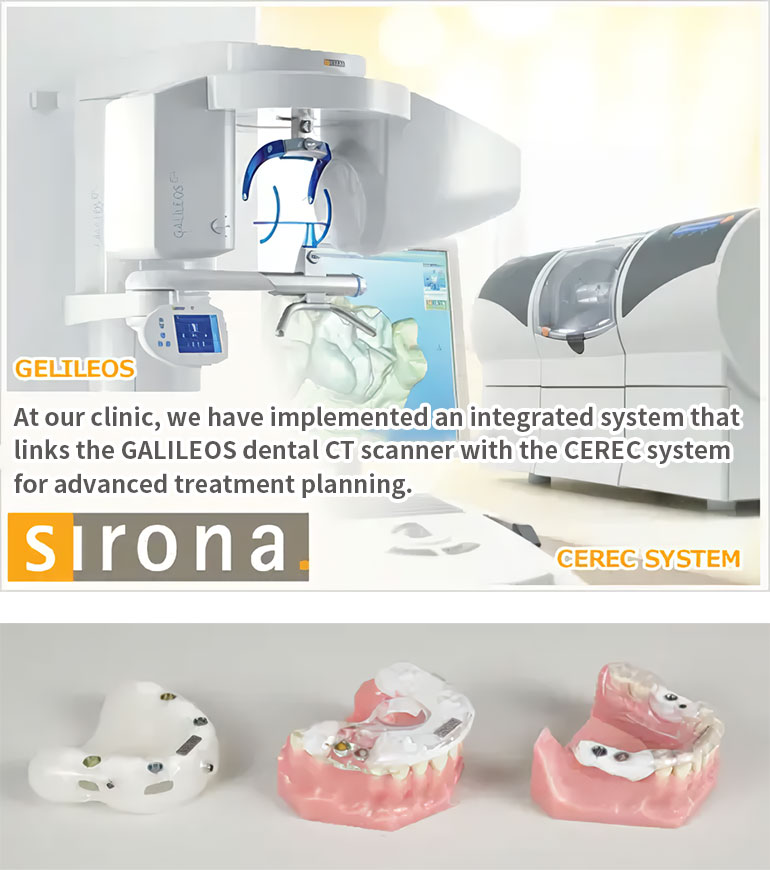
CEREC
What is CEREC?
CAD/CAM System for Ceramic Restorations
CEREC is a system that allows for the digital design and milling of ceramic restorations using a computer system. With CEREC, high-quality, natural-looking ceramic crowns and inlays can be made quickly and cost-effectively.
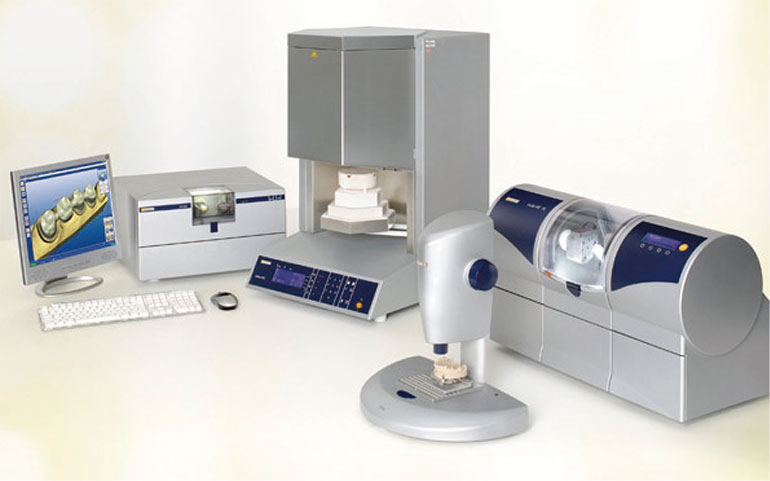
Ceramic Inlays and Crowns
Inlays (Fillings)
Inlays are restorations used to fill areas of a tooth that have been removed due to cavities. Among the various materials available, ceramic inlays offer superior strength, are highly resistant to discoloration over time, and can be color-matched for a completely natural look—making the restoration virtually unnoticeable.
Cost: ¥66,000 (tax included)
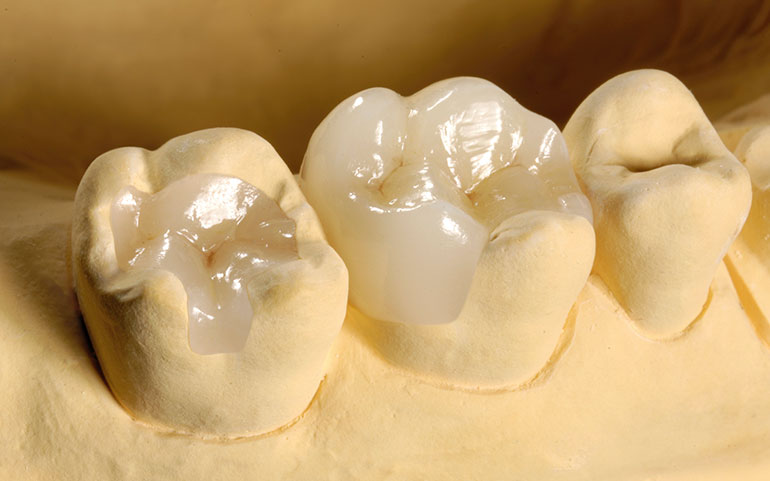
Crowns (Caps)
Crowns are artificial teeth placed over natural teeth that have been shaped to serve as a base. Insurance-covered crowns are typically made of metal with a plastic coating, which can yellow with age. All-ceramic crowns, on the other hand, offer a natural appearance with excellent translucency and no risk of metal allergies. They are ideal for highly visible front teeth.
Cost: ¥121,000 (tax included)
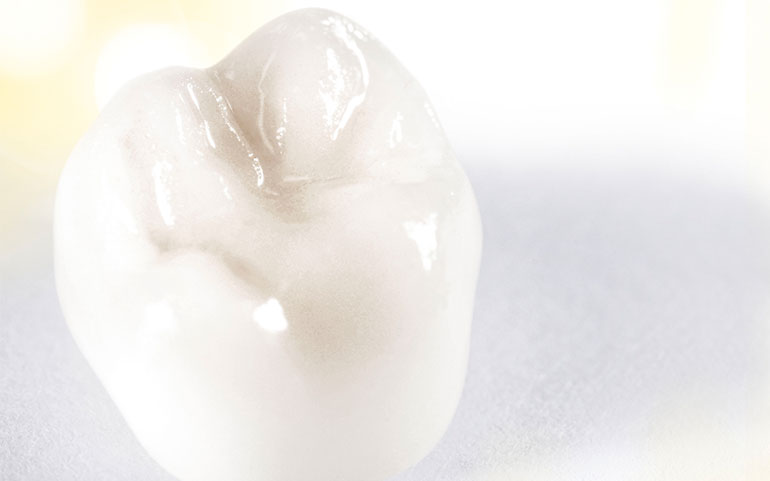
Features of CEREC
Aesthetics
Ceramic materials closely match the color of natural teeth, resulting in a beautiful and natural finish.
Biocompatibility
Durability
CEREC ceramics are as strong as gold, which has long been considered the most durable material in dentistry. Unlike plastic, ceramic does not change in color or shape over time.
Speed
If you are in a hurry, it is also possible to set the white ceramic restoration on the same day you visit.
Affordability
Although not covered by insurance like gold, CEREC restorations are more economical due to the computerized and efficient production process.
CEREC Treatment Process

Scanning (Impression)
After shaping the tooth, a 3D optical camera is used to scan the mouth
After preparing the tooth, a 3D camera captures a digital impression. This replaces traditional, uncomfortable molds. In just a few seconds, a digital model appears on the monitor. Note: Some cases may still require conventional impressions.
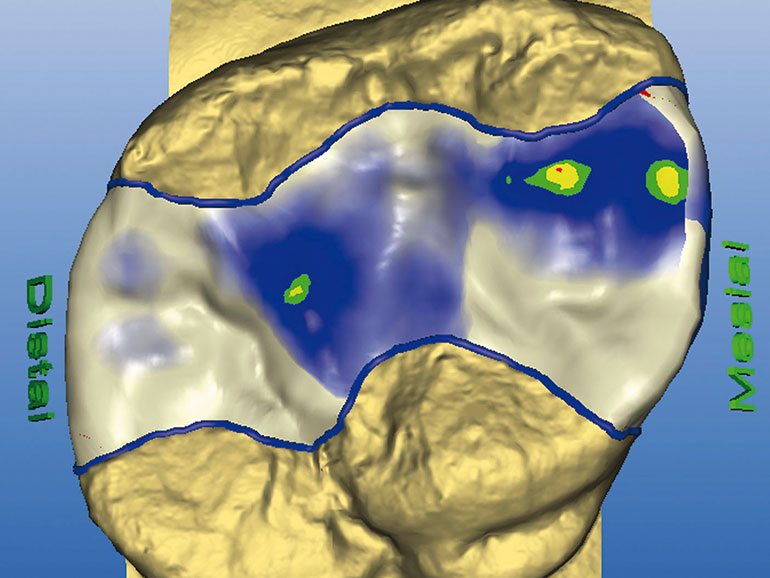
Designing the Restoration
Restoration is designed on a 3D screen
The restoration is digitally designed, adjusting the shape and bite from all angles. Once the design is complete, a ceramic block in the most suitable shade is selected.
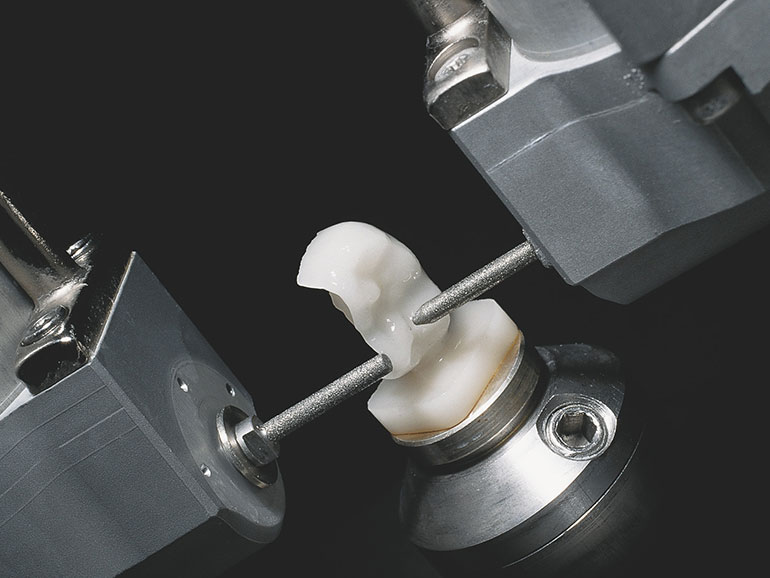
Milling the Restoration
Milling machine fabricates the restoration based on the design
A milling machine (CAM) sculpts the ceramic block based on the digital design, creating a highly accurate and custom-fitted restoration.

Setting the Restoration
The finished restoration is placed and bonded in the mouth
The milled ceramic restoration is placed in the mouth and securely bonded. This completes the treatment. The entire process from Step 1 to Step 4 usually takes about one hour.
Even White Fillings Can Look This Beautiful!
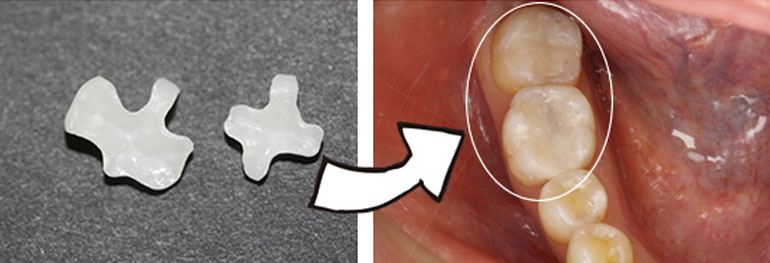
Omnicam (For Patients)
inEos X5
FAST
Efficient scanning with high speed
PRECISE
High precision through advanced scanning technology
AUTOMATED
Automatic scanning and auto-focus ensure accuracy
By fabricating zirconia frameworks in-house, we can now offer CEREC-based bridges that were previously not possible with the CEREC system alone!
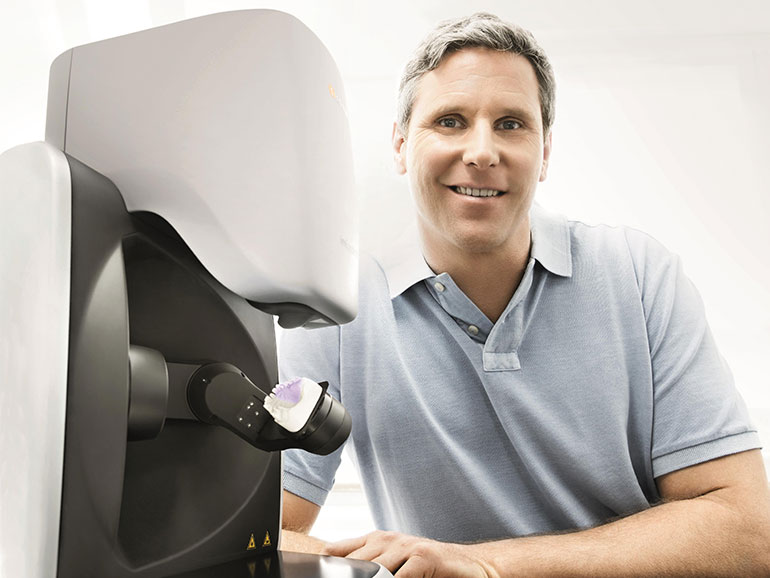
e.max
e.max is a type of ceramic material that combines both aesthetics and durability. With high biocompatibility, making it safe for patients with allergies, but also contains aesthetic properties that offer optimal color, translucency, and brightness that are similar to natural teeth.
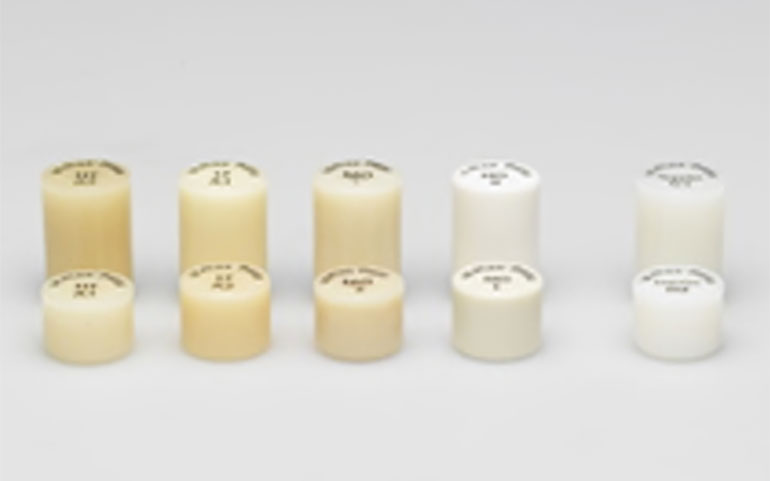
Features of e.max
- Metal-free and highly translucent, e.max comes in four levels of transparency, allowing for a very natural and aesthetic finish that closely resembles natural teeth.
- It is neither too soft nor too hard, which helps significantly reduce the risk of fractures or excessive wear on opposing teeth due to friction.
- High strength and durability ensure long-lasting stability, potentially extending the life of the opposing teeth as well.
- e.max bonds closely with the natural tooth structure, resulting in a seamless margin that makes it difficult for bacteria to enter—reducing the risk of secondary cavities.
Orthodontic Treatment
Thinking About Straightening Your Teeth? We’re Here to Help.
Our clinic offers orthodontic treatment for a wide range of ages—from early preventive care in young children to full orthodontic correction in adults.
Every Saturday, a specialist from the Department of Orthodontics at Iwate Medical University Dental Hospital visits our clinic to provide expert care.
If you are concerned about the alignment of your teeth, please feel free to consult with us.
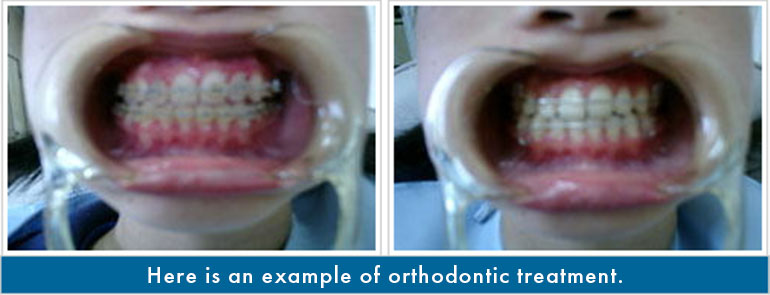
What Is Orthodontic Treatment?
Orthodontics is not only about improving the appearance of your smile or facial balance by correcting crooked teeth or misaligned bites.
It also helps improve chewing function, speech, proper growth and development of the teeth and jaw, and the prevention of dental and periodontal diseases.
Ultimately, orthodontic care contributes to both your physical and emotional well-being.
Treatment Timeline
The goal of orthodontic treatment is to achieve a well-aligned set of permanent teeth.
For children in the baby teeth (primary dentition) or mixed dentition stage (a combination of baby and adult teeth), treatment may take longer.
To make the process more effective, we divide the treatment into two phases:
Phase 1 Treatment
This phase typically begins during the primary or mixed dentition stage (around 6th grade to early junior high school).
The focus is on simple bite correction, jaw expansion, and creating a solid foundation for proper tooth alignment in the future.
Phase 2 Treatment
Starting in the permanent dentition stage (around junior high school age and older), this phase involves moving individual teeth into their correct positions to create a well-aligned bite.
Tooth movement usually takes about 2 to 3 years, but the duration can vary depending on individual tooth movement and how well the appliances are used.
During this period, patients typically visit the clinic once a month.
Cost of Treatment
Currently, orthodontic treatment is not covered by Japanese health insurance unless it involves cleft lip and palate or jaw deformities requiring surgery.
As such, it is considered a private, out-of-pocket expense.
| Consultation Fee | ¥3,300 (tax included) |
|---|---|
| Initial Examination & Diagnosis | ¥30,000 (tax included) |
| Orthodontic Treatment Fee | ¥385,000 – ¥825,000 (tax included) |
| Adjustment Fee (each visit) | ¥3,300 (tax included) |
※As of November 2023